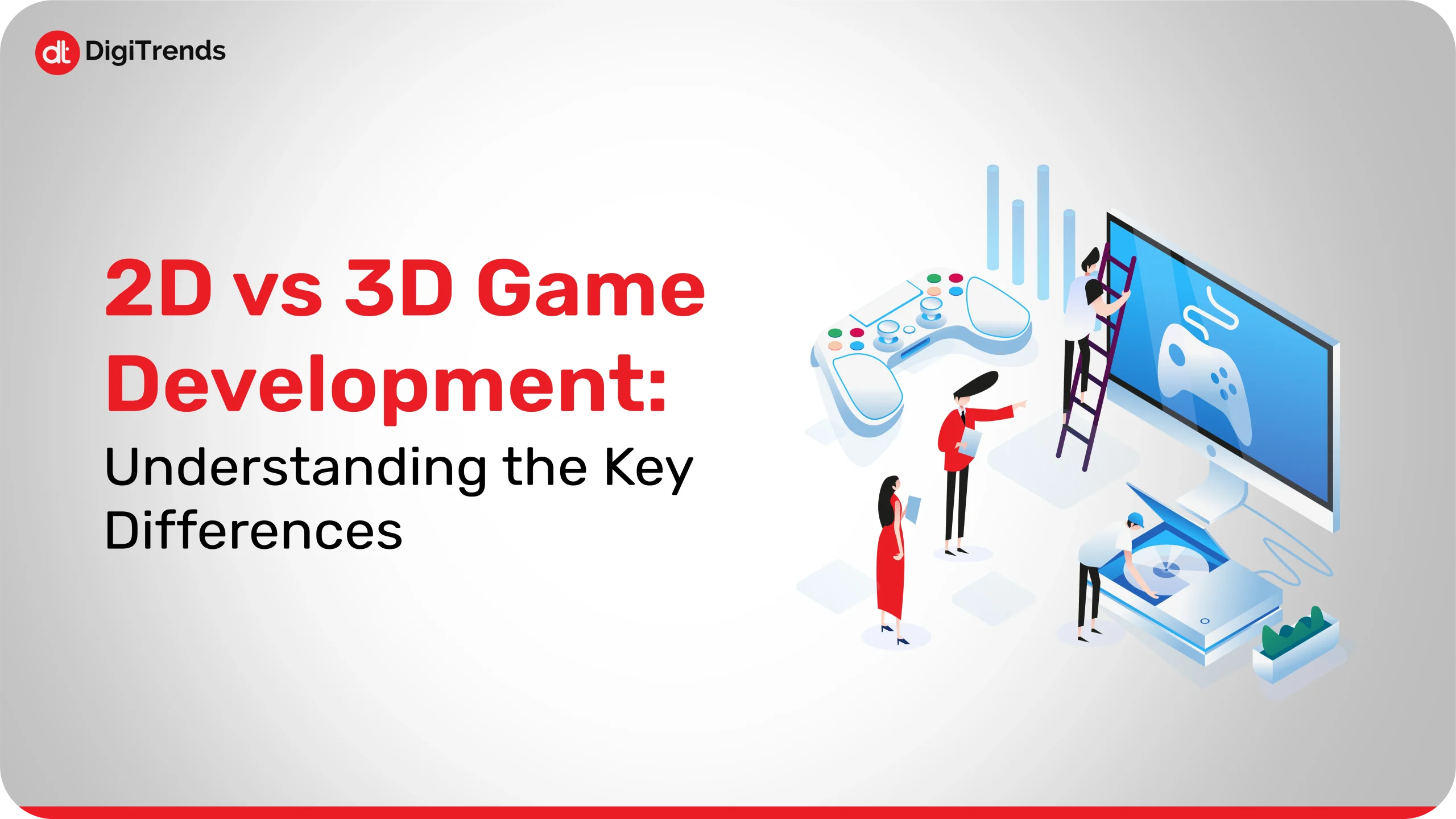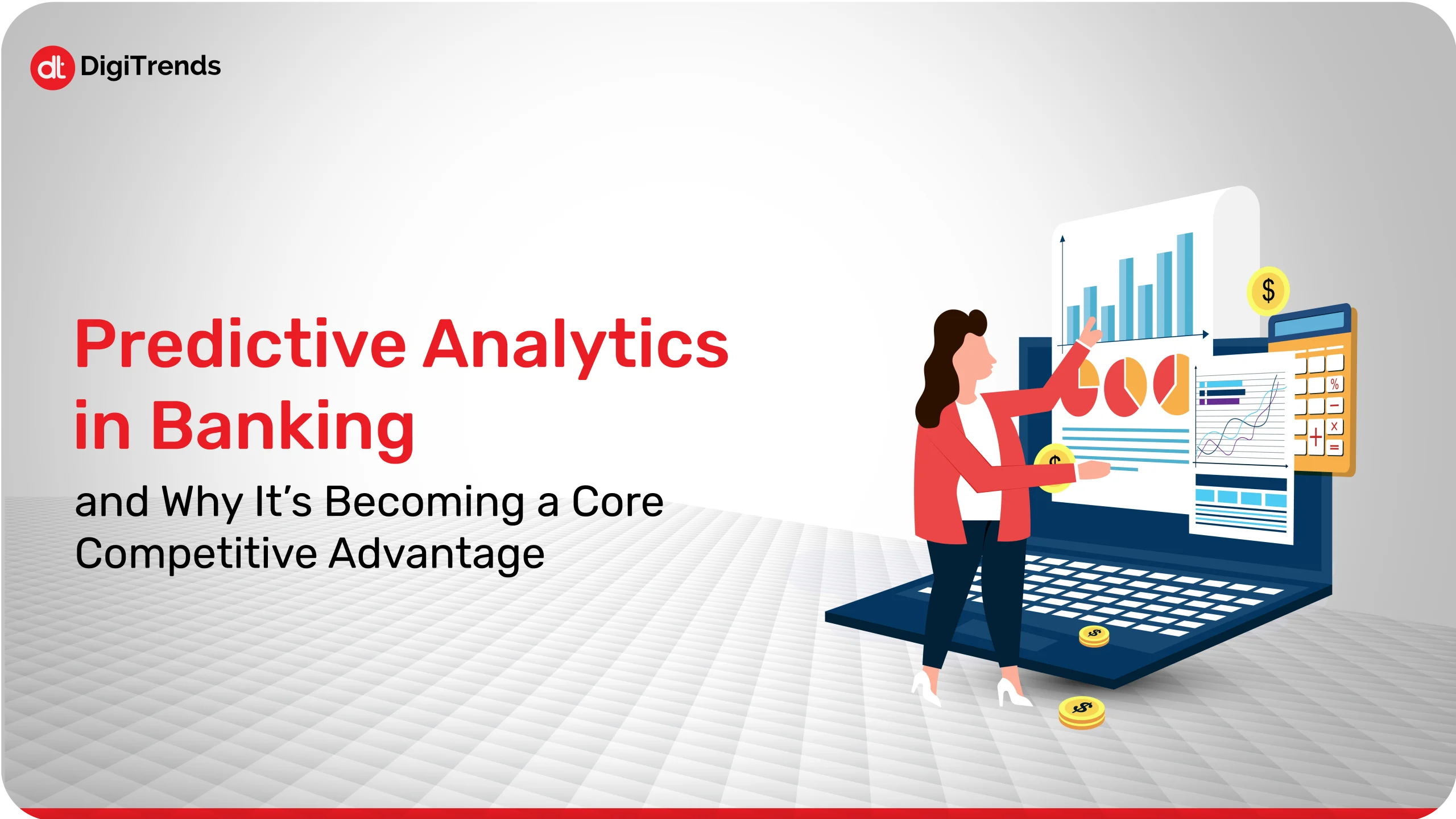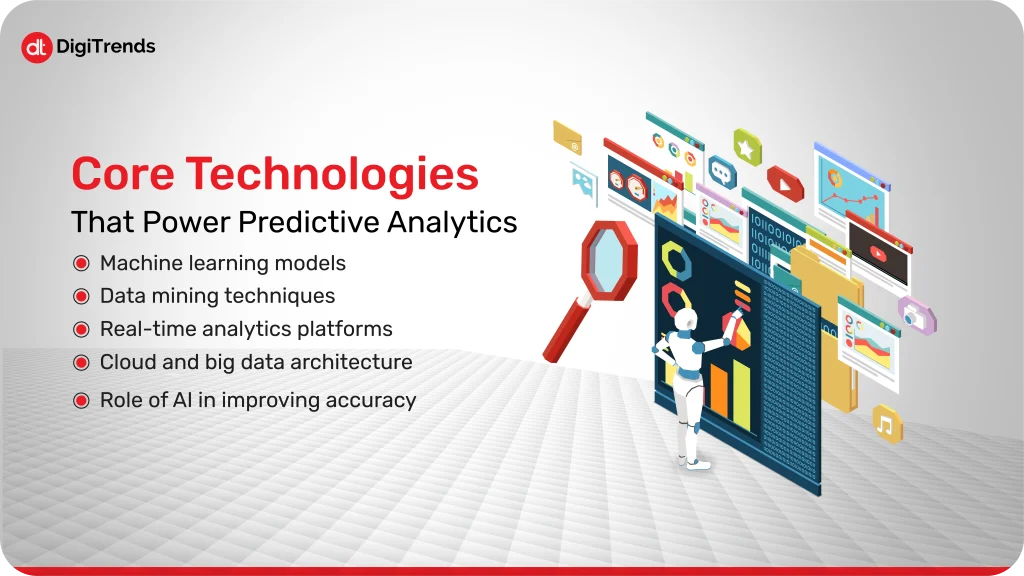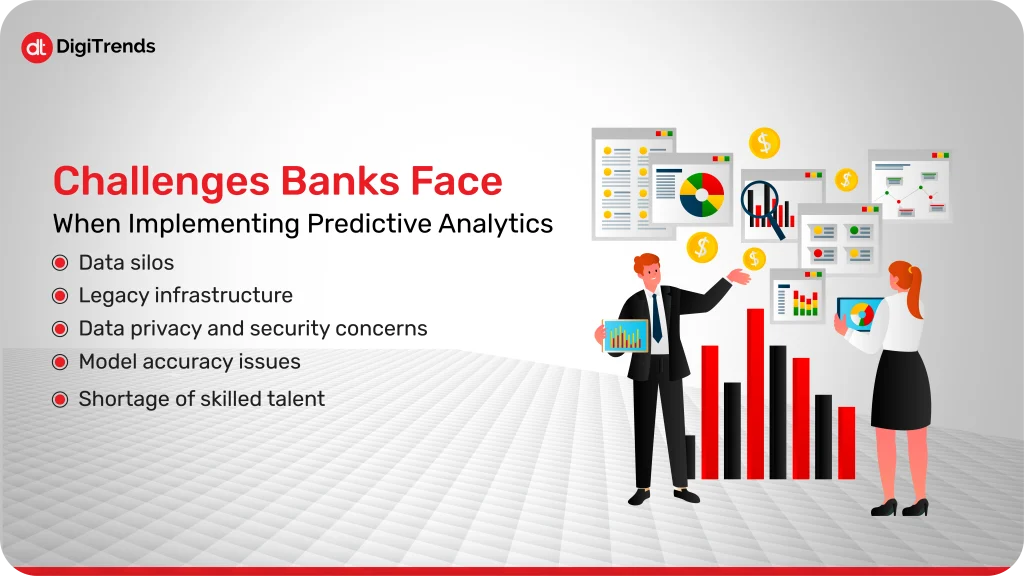
2D vs 3D Game Development: Understanding the Key Differences
Explore the practical differences between both formats, the cost differentiation, the tools, and the how much creative freedom both offer.
Continue Reading
There was a time when banking meant walking into a branch, waiting for your turn, and moving forward with your transactions. The decisions regarding money matters took days, sometimes weeks too, because everything was dependent on paperwork, it took human judgment, and manual checks were done to make sure of no errors.
Fast forward to today, and the entire banking system is different.
Now we transfer money through apps, apply for loans online, and get answers to our money-related problems in minutes. Banks now manage a huge stream of data, so it’s not just about managing accounts anymore; banks gather constant data from every direction.
The challenge in this system is that with new information coming in every day, banks need to make smarter decisions quickly while also being accurate.
How can predictive analytics help banks make smarter and faster decisions?
With everything moving so fast and customers expecting faster solutions, banks can no longer wait for issues to unfold and then take required actions because customers can instantly switch to other competitors if they are dissatisfied with the services. Another problem is that markets shift really fast, and unexpected risks sometimes appear out of nowhere in the fintech industry. So, if banks still rely on older methods, they might end up reacting to the problem very late.
To solve this challenge, the fintech industry is now turning to data models like predictive analytics so it can be better prepared.
Wondering what predictive analytics in banking is other than charts or monthly reports?
Now you have the answer. It is about using data to understand what can happen in the future.
The impact of predictive analytics in banking is noticeable and positive. It is because, with the help of this system, frauds are caught before they become a major problem, and loans are approved with good accuracy. When it comes to customers, they also receive offers that are relatable to them. Overall, predictive analytics for banking & financial services reduces the guesswork, which was once the foundation of the industry.
Explore what predictive analytics in banking really is, how it works, and why so many financial institutions are now using it as their main strategy.
Predictive analytics in banking might sound like another fancy term of the banking industry, but in reality, it gives financial institutions the power to turn data into foresight. The main work of this system is to use previous and real-time data to forecast what might happen in the future, which then helps banks in making faster and better decisions based on the predictions.
Imagine every transaction, every interaction, and every click by the customer creates a footprint. Amazing right?
Every piece of data in fintech creates a story, and when this story is combined with advanced models and algorithms, it can form a pattern that can reveal what might happen in the future. That’s how predictive analytics in financial services works.
To make the predictions accurate, financial institutions rely on different data sources, like:
With the help of these data sources, predictive models identify the patterns that humans can often miss. This is really helpful in areas like customer analytics in banking, because in this area, it is really important to understand what the customers need and then predict their behaviour accordingly to gain loyalty and revenue.
The true potential of predictive analytics in banking & financial services is turning uncertainty into opportunity. From predicting fraud to offering personalized services to customers, predictive analytics gives banks the power to see what’s coming and be competitive in the highly competitive fintech market. According to research, the global predictive analytics in banking market size is projected to reach USD 19.61 billion by 2033.

Predictive analytics in banking is no magic; it is quite obvious that it is backed by many technologies that help the system to turn data into insights that banks can take action on. If you are looking to invest in this system for your company, then understanding the tools involved is important. Let’s have a look at what technologies are used to back the predictive analytics system:
At the heart of banking predictive analytics is machine learning. The algorithms learn from previous data and identify patterns in the activities to make smarter predictions.
For example, the model will predict the chances of a customer defaulting on a loan or also detect any unusual activity that suggests fraud is going to take place. These models also improve with time as they work and work on different cases, so with every new case, the predictions become more accurate.
Finding hidden patterns in large datasets is the goal of data mining. Finding customer groups that are likely to react to a new product or identifying associations between risk factors and spending patterns are two examples of predictive analytics in banking. Unstructured, chaotic data is transformed into structured insights by data mining, which decision-makers can use.
It is safe to say that the fintech industry is moving at the right pace as technology grows day by day, so if there are any delays in important decisions, it can cost the company a lot of money. With real-time analytics, banks can process the incoming data instantly. No matter what it is, from monitoring transactions to detect fraud or providing instant credit scoring, real-time tools make predictive analytics actionable as events happen.
The banking data is huge, as it keeps upgrading every day, and more data means more storage and processing capabilities needed.
Big data and cloud infrastructure help banks in storing and analyzing large amounts of data, and that too efficiently. This infrastructure supports advanced analytics models and ensures scalability as the volume of data grows.
Predictive analytics in banking & financial services is itself a really powerful tool. Artificial intelligence helps in enhancing the model by adding a layer of judgment based on how humans reason and make decisions. When it is used in combination with automation, it can help banks take action on the predictions quickly. For example, banks can send personalized service offers or send out an alert if there are high chances of a risk, without involving and waiting for the approval of a human entity.
By combining all these technologies, banks can leave behind the traditional analytics methods that focused on what happened and move to predictive analytics that predict what the future holds. These technologies are basically the backbone of banking predictive analytics, which helps banks gain a competitive advantage in the market.
It is pretty clear now that predictive analytics in banking is not just to be considered as a technological shift or upgrade, but a strategic one. If a bank adopts this model now, it will not only improve its operations but also gain a competitive advantage that will directly impact its revenue, risk management, and customer loyalty. Let’s have a look at why it has become a core competitive advantage.
Understanding your customer’s behavior pattern and what they are going got do next can be very valuable information, and that’s exactly what customer analytics in banking offers. It helps predict if a customer is ready for a new credit card, a loan, or any other financial product. When the customer’s needs are predicted before they even ask for it, banks can offer them services according to the solutions they need before the competitors can even reach them. This helps in creating a better connection between the bank and the customer and results in higher conversion rates, too.
Traditional banking uses static reports and manual reviews to make decisions for the future, whereas with predictive analytics in banking & financial services, they can make faster decisions that are also data-driven. So, whether it’s approving loans, flagging risky transactions, or allocating resources efficiently, predictive models reduce guesswork and speed up response times.
There is no doubt in the fact that risk is a major part of banking, but uncontrollable risk can be very dangerous. Predictive analytics in financial services allows banks to know about potential defaults, market shifts, or operational threats. If the banks get to know about the scenarios that can occur, they can easily take the required actions before they become a major problem for them.
Predictive analytics is not only for predicting revenues, risks, and opportunities, but it can also improve the internal operations of the bank. It can optimize staffing at different branches, manage ATM cash reserves, and forecast demand for loans. With this information in hand, banks can better allocate their resources and efficiently reduce their operational costs.
Customers in today’s market expect customized services rather than generic ones. Predictive analytics makes it possible for banking and financial services to provide proactive support and customized recommendations, increasing customer satisfaction and loyalty.
Perhaps the biggest advantage is that predictive analytics transforms how banks compete. Institutions that rely solely on historical data or gut instincts risk falling behind. Banks that harness predictive insights operate with foresight, making them faster, smarter, and more resilient.
In short, predictive analytics turns data into actionable insight, and insight into measurable advantage. Banks are no longer just managing accounts; they’re managing outcomes.
Next, we’ll look at the major use cases in banking, showing how predictive analytics applies to real-world scenarios, from fraud detection to credit assessment.
Predictive analytics in banking isn’t just theory; it’s actively shaping how financial institutions operate every day. From reducing risk to enhancing customer experience, here are the key areas where predictive analytics is making a real impact.
One of the most critical areas for banks is managing credit risk. Banking predictive analytics models analyze historical repayment data, income patterns, and spending behaviors to forecast the likelihood of loan defaults. This allows banks to:
The result is better risk management and improved profitability for banks, without slowing down the loan approval process.
Financial fraud is evolving rapidly, and real-time detection is essential. Predictive models monitor transactions for unusual patterns or anomalies that could indicate fraudulent activity. By analyzing customer behaviors, location patterns, and transaction amounts, banks can flag suspicious activity instantly. This not only prevents losses but also strengthens customer trust.
Losing a customer can be far more costly than acquiring a new one. Customer analytics in banking helps identify customers at risk of leaving by analyzing transaction trends, product usage, and engagement levels. Banks can then take proactive measures such as personalized offers, targeted communication, or loyalty incentives to retain high-value clients.
Predictive analytics in financial services enables banks to understand what products and services a customer is likely to need next. By leveraging insights from transaction history, spending habits, and demographic data, banks can offer:
This personalization improves conversion rates and enhances customer satisfaction.
Predictive models can also anticipate cash flow needs and demand for banking services. For instance, predicting branch-level footfall, ATM cash requirements, or seasonal loan demand ensures efficient resource allocation. This leads to smoother operations and cost savings.
Banks face increasing regulatory requirements. Predictive analytics helps monitor transactions and flag potential compliance issues before they escalate. Automated alerts and predictive reporting make it easier to stay ahead of audits and regulatory changes, reducing risk and ensuring adherence to laws.
Implementing predictive analytics in banking goes beyond technology; it delivers measurable benefits that transform how banks operate and compete. Here’s how banks gain from using predictive analytics and why it has become a strategic necessity.
By understanding customer behavior and preferences, banks can anticipate needs and offer the right products at the right time. Customer analytics in banking allows for targeted marketing, personalized product recommendations, and cross-selling opportunities that drive higher revenue without adding extra cost.
Predictive models optimize internal processes. From staffing at branches to ATM cash management and loan processing, banks can allocate resources efficiently. This reduces unnecessary overhead and improves overall operational efficiency.
Risk is inherent in banking, but predictive analytics allows institutions to foresee potential issues before they become costly. By analyzing trends in loan repayment, transaction anomalies, or market shifts, banks can mitigate risks proactively, reducing losses and protecting their balance sheets.
In a fast-moving financial environment, speed is critical. Predictive analytics enables real-time or near-real-time insights, allowing banks to make decisions quickly, whether it’s approving loans, flagging fraud, or adjusting investment strategies.
Personalization is no longer optional. Predictive analytics in financial services allows banks to deliver customized experiences, anticipate customer needs, and proactively address pain points. Satisfied customers are more loyal, generate repeat business, and even become brand advocates.
Perhaps the most significant benefit is strategic positioning. Banks that use banking predictive analytics effectively can respond to market changes faster, manage risks better, and serve customers more intelligently. This advantage differentiates them from competitors who rely solely on traditional analytics or reactive strategies.
In essence, predictive analytics transforms banks from reactive institutions to proactive, insight-driven organizations. The next step is understanding the challenges banks face when adopting predictive analytics and how to overcome them.

While predictive analytics in banking offers significant advantages, implementing it is not without challenges. Financial institutions must navigate several hurdles to fully realize the benefits.
Many banks have data scattered across multiple systems, from legacy core banking platforms to mobile apps and CRM tools. Predictive models require unified, high-quality data. Without breaking down silos, insights can be incomplete or inaccurate, limiting the effectiveness of banking predictive analytics.
Older systems may not support the large-scale data processing required for predictive analytics. Outdated software, limited storage, and slow processing speeds can hinder real-time analytics and model deployment, making modernization a necessary but sometimes costly step.
Banks handle sensitive information, so data security is paramount. Collecting and analyzing customer data for customer analytics in banking must comply with privacy regulations like GDPR or regional financial data laws. Mishandling data can result in regulatory penalties, reputational damage, and loss of customer trust.
Predictive models are only as good as the data and assumptions behind them. Poor-quality data or biased historical trends can produce inaccurate predictions. Banks need continuous model monitoring, testing, and refinement to ensure insights remain reliable.
Building and maintaining predictive models requires expertise in data science, machine learning, and financial analytics. Many banks struggle to recruit and retain talent with the right combination of technical and domain knowledge, slowing the adoption of predictive analytics for banking & financial services.
Shifting to a predictive approach requires more than technology; it demands cultural change. Teams must trust data-driven insights and adjust workflows accordingly. Resistance from staff or leadership can limit the impact of predictive analytics initiatives.
Despite these challenges, banks that strategically address these obstacles can unlock the full potential of predictive analytics. The key is combining technology, skilled talent, and strong governance.
The future of banking is being written in data, and predictive analytics in banking is at the heart of it. As institutions adopt these tools, the way banks operate, interact with customers, and manage risk is evolving dramatically.
Predictive models allow banks to anticipate individual customer needs, offering tailored products and advice before a customer even asks. Customer analytics in banking will enable banks to deliver hyper-personalized experiences, from customized savings plans to predictive investment guidance, turning each interaction into a value-generating opportunity.
Predictive analytics transforms risk management from reactive to proactive. By analyzing real-time transaction data, economic indicators, and market trends, banks can anticipate threats, such as potential loan defaults, liquidity issues, or fraudulent activity. This capability reduces losses and strengthens financial stability.
With predictive models, AI-driven tools like chatbots and virtual assistants will become smarter. They can understand customer intent, predict needs, and deliver solutions seamlessly. For example, a banking app could predict when a customer might need a loan or detect unusual spending patterns, prompting immediate guidance.
Predictive analytics isn’t just about sales or loans; it can also safeguard banks. By analyzing patterns in network activity and transactions, banks can detect and prevent fraud or cyberattacks before they escalate, ensuring customer trust and regulatory compliance.
As banks rely more on data-driven insight, traditional structures are changing. Predictive analytics enables digital-first models, such as fully automated lending platforms, dynamic pricing for products, and adaptive investment services. These innovations will define which institutions lead the market in the next decade.
The future is clear: banks that embrace predictive analytics will be faster, smarter, and more responsive. Those that don’t risk falling behind competitors who leverage these insights to anticipate trends, manage risks, and build stronger customer relationships.
Adopting predictive analytics for banking & financial services can feel complex, given the volume of data and the sophistication of models required. DigiTrends can support banks in navigating this landscape by offering services on building predictive models, developing data strategies, and integrating analytics into existing systems. We can help institutions identify relevant data sources, structure pipelines for accuracy, and ensure insights are actionable for decision-making.
Additionally, DigiTrends can provide products for scaling predictive solutions, optimizing model performance over time, and adapting strategies to evolving business goals or regulatory requirements. The focus is on helping banks leverage predictive analytics effectively to gain insights, manage risks, and create more personalized experiences for their customers.

Predictive analytics in banking is no longer just a technical tool; it’s a strategic advantage. By transforming data into foresight, banks can anticipate customer needs, manage risks proactively, optimize operations, and create personalized experiences that build loyalty. Customer analytics in banking, real-time insights, and predictive models allow institutions to operate faster and smarter than ever before.
The shift from traditional analytics to predictive approaches is reshaping the industry. Banks that embrace these capabilities position themselves to stay ahead of competitors, respond to market changes effectively, and deliver services that meet the evolving expectations of customers.
As financial services continue to evolve, predictive analytics for banking & financial services will play an increasingly critical role in defining which institutions lead and which fall behind. Investing in these insights today is not just about keeping up; it’s about building a foundation for sustainable growth and long-term success.